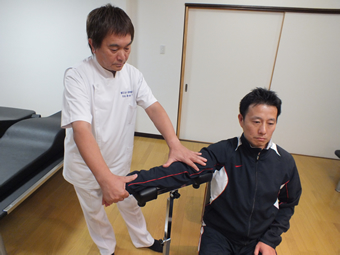

General consideration III


- Symptom
- This problem is often found in handball, volleyball, basketball, softball, and kendo (Japanese art of fencing), in which the athletes raise their hands over the shoulder. This fact is attributed to "inversion of chronic functions of muscle", which is characteristic of the upper limb muscle groups. To be more specific, a muscle changes the way it works when it crosses over a certain angle.
- Tamatare Remedy
- Tamatare Remedy effectively extends the muscle groups overlaying one another, stimulates the motor reflex arc along the nerve tract by multi-angle extension of muscles, and recovers the metabolism efficiency of the problematic muscles to cure the elbow pain caused by these problems.
- Details
- In the case of the pectoral major muscle, for example, it has bending effect at an abduction angle up to 120 degrees. When it crosses over that angle, however, it shifts to have abduction effect. Other examples include inside and outside turns of the brachioradialis muscle and forward and backward bending (contraction and extension) of the head by the sternocleidomastoid muscle. If there is anything that hinders this muscle function, other muscles that coordinate with these muscles and those that exerts opposing forces become unable to operate sufficiently, leading to the loss of muscle strength. When the biceps brachii muscle becomes weak, inside turns of the elbow become dominant over the outside turns, and this overloads the elbow bending movement. When the extensor muscle becomes weak, the force of dropping the arm from over the shoulder becomes weak, causing overwork on that movement. Elbow pains caused by this problem are found in many athletic events. Loss of muscle strength caused by these coordinated operations of muscles deteriorates without the person's realizing it, and eventually induces pains and develops to a serious problem.



General consideration III








